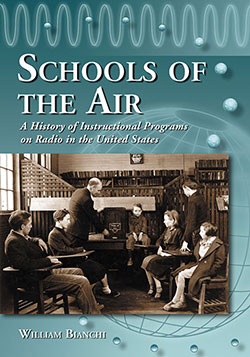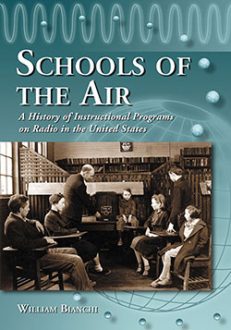Schools of the Air
A History of Instructional Programs on Radio in the United States
$39.95
In stock
About the Book
Born in the 1920s during the emergence of radio, schools of the air broadcast an impressive array of instructional programs for the classroom. These broadcast schools operated at the national, state and local levels; issued teacher manuals and learning materials; and offered enormous educational resources to students in both rural and urban areas. This work gives the history of 14 schools of the air, and fills an important gap in scholarship about American education and broadcast media. The book also assesses the successes and failures of the school of the air movement, and examines reasons for its demise.
About the Author(s)
Bibliographic Details
William Bianchi
Format: softcover (7 x 10)
Pages: 336
Bibliographic Info: 27 photos, tables, notes, bibliography, index
Copyright Date: 2008
pISBN: 978-0-7864-3058-1
Imprint: McFarland
Table of Contents
List of Tables ix
Abbreviations Used xi
Preface 1
Introduction 5
SECTION I: RADIO BECOMES AN EDUCATIONAL MEDIUM 7
Early Years: Idealism and Commerce 8
Education and Regulation 13
Three Experiments 17
A National School of the Air? 21
Schools of the Air Emerge 27
Summary 34
SECTION II: NETWORK SCHOOLS OF THE AIR 35
NBC’s Music Appreciation Hour 35
CBS and the American School of the Air 52
Summary: Network Schools of the Air 75
SECTION III: STATE-BASED SCHOOLS OF THE AIR 79
Ohio School of the Air 80
Wisconsin School of the Air 102
Minnesota School of the Air 143
Texas School of the Air 161
New York: The Empire State FM School of the Air 171
Oregon School of the Air 184
The Prairie Farmer: WLS’s School Time 195
Summary: State-Based Schools of the Air 197
SECTION IV: LOCAL SCHOOLS OF THE AIR 206
Cleveland School of the Air 207
Chicago Public School of the Air 221
Rochester School of the Air 234
Portland, KBPS 241
WNYE School of the Air 262
Detroit 270
Limited Data Local Schools of the Air 275
Alameda City School of the Air 275
Akron, Ohio 280
Summary: Local Schools of the Air 284
SECTION V: OPPORTUNITY LOST? 291
Summary of Findings and Conclusions 296
Reasons for Demise 301
Successes 303
Why Did Not More Teachers Use Schools of the Air? 304
The Wisconsin Exception 306
Other Measures of Success 307
Questions and Lessons Learned 309
References 313
Index 321
Book Reviews & Awards
“An important and useful study that captures a period in radio’s history for which a modern history had been lacking”—Communication Booknotes Quarterly.





